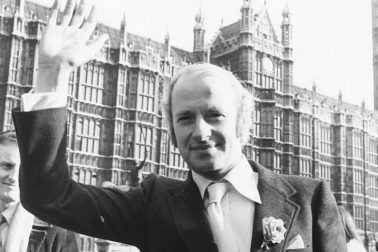‘If I can’t see a factory from up here,’ I mutter to myself, throwing the car round an uphill bend of the B5032 south of Ashbourne, ‘I must be in the wrong county.’ But no, I’m not lost; there below me is a long pale slab of a building that announces itself as JCB World Headquarters — adding, on a giant polythene wrap, ‘Celebrating 1,000,000 Machines May 2013’. Equidistant between the Rolls-Royce aero-engine works at Derby and the potteries of Stoke-on-Trent, what I’m looking at is the beating heart of what’s left of industrial England.
I’m here for lunch with the man whose fiefdom it is, the recently ennobled Lord Bamford. His father, Joseph Cyril Bamford, broke away from the family agricultural engineering business (actually his uncle sacked him) to start on his own in a garage in Uttoxeter on 23 October 1945, and to turn his initials into one of the world’s best recognised construction-site brands. One million diggers and ‘backhoe loaders’ later, Joe’s son Anthony — born that same day, chairman since 1975 — is still very much in charge.
He’s small and soft-mannered, boyish for his age, and his fortune tied up in this privately owned business is estimated at £3 billion. In terms of longevity, brand power and disdain for public capital markets, his nearest peer is Sir Richard Branson — now semi-retired to the role of offshore celebrity stuntman rather than hands-on executive. So what makes Anthony Bamford want to go on meeting customers, driving innovation and flying backwards and forwards to India, where JCB has a parallel manufacturing business? ‘Someone asked me the other day, wouldn’t you rather be out shooting? Well, I do like shooting, but head-and-shoulders I prefer working. It’s as simple as that.’
And his dedication is evident from the décor of his office: no hunting prints, just acrylic canvases themed on the JCB logo — and lined up on every surface, bright yellow JCB toys. Instead of a silver pheasant on the lunch table sits a model of JCB Dieselmax, the supercar that set a diesel-powered land speed record of 317mph on the Bonneville Salt Flats in 2006. It was a personal project for the then Sir Anthony, and it arose from the fact that JCB used to buy engines from Perkins of Peterborough until Perkins was acquired by Caterpillar of the US, JCB’s hardest competitor; so JCB decided to build its own engines (with design advice from another world-leading but unsung British company, Ricardo of Shoreham) and Bamford decided to prove their power by putting two of them in the pencil-sleek Dieselmax.
A less show-off illustration of devotion to R&D is the ‘clean burn’ technology of JCB’s latest engines, doing away with the need for a bulky add-on called a diesel particulate filter — which means the engine can be smaller, the hood a little lower, and the driver’s view of his digger bucket a little better. Though hand-built like Bentleys, these are workaday machines that strive to be more robust, fuel-efficient and adaptable to users’ needs than those built by Caterpillar, Komatsu of Japan or Liebherr of Germany. A play on old Joe’s initials was the nickname ‘Jamais Content’, blazoned on the factory corridors, and the search for continuous improvement in product and method is clearly part of the corporate DNA.
Staying private
But even this most focused of businesses, with its benign billionaire boss, was far from immune to the post-2008 recession: annual output of JCB vehicles fell from 72,000 to a low of half that number, and there were redundancies. Output is now close to 70,000 again, profits hit a record last year, UK orders are strong — and I ask Bamford what difference it makes to be free of the whims of the stock market in difficult times. ‘If we’d gone public in the 1960s when my father thought about it, we’d have been taken over years ago, by Americans probably, and we’d be long gone. Since I became chairman we’ve never even considered it.’
He tells the story of the time his father came closest to selling — in the late 1960s, when the Labour government’s Industrial Reorganisation Corporation was pushing mergers to create ‘national champions’ and introduced the industrialist Donald Stokes, who wanted JCB to be part of what would become the calamitous British Leyland conglomerate. Joe, Anthony and Stokes were lined up at the urinals of the Dorchester Hotel: ‘I’ll give you £22 million,’ said Stokes. ‘No,’ said Joe. ‘Twenty-five.’ ‘No.’ ‘OK, the best deal of your life, £33 million in Leyland shares.’ If Joe hadn’t declined a third time, says his son, ‘Those shares would ultimately have been worth about 33 pence.’
Going German
What kind of state intervention, if any, would Bamford welcome today? He’s an ardent admirer of the German system, with its emphasis on technical education and R&D, its multiplicity of sources of bank finance, its high productivity and its prowess as the world’s largest net exporter (the UK comes a poor 19th). We’ve had no worthwhile industrial policy in this country for decades, he says, but more and simpler capital allowances for business investment would certainly help — many firms don’t understand the reliefs to which they’re already entitled — and the really urgent problem, the one on which he feels he can best contribute from the red benches, is the chronic lack of skills that will hold back any resurgence of British manufacturing.
His company has made its own contribution on that front by sponsoring an academy school specialising in engineering in the nearby village of Rocester. Opened in 2010, it now has 580 pupils drawn from a wide catchment area who ‘spend half their day in blue overalls’ and will go on to factory apprenticeships or engineering degrees. It’s a small start, but it neatly connects the modern manufacturing icon that is JCB with a famous name from the past. Its building was Richard Arkwright’s 18th-century water-powered cotton mill, and it tells us our industrial heritage is still alive in the byways of rural Staffordshire.







Comments